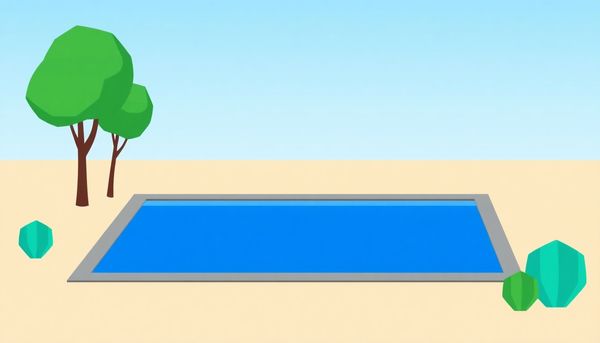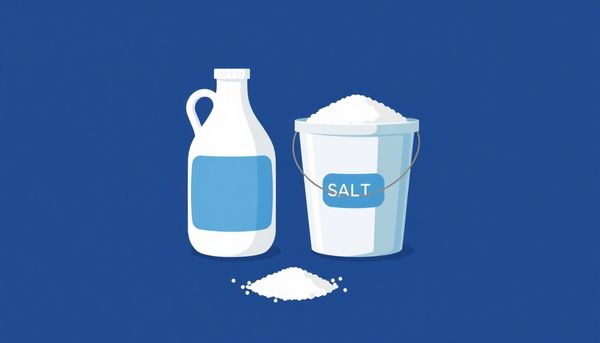Why Homeowners Are Choosing Salt Water Pools Over Chlorine
May 08th, 2024
May 08th, 2024
Swapping out the typical backyard pool for a salt water alternative is a decision more homeowners are exploring. The notion of floating in water that echoes the ocean's gentle touch has an undeniable allure. Growing up, my family had a chlorine pool, and I distinctly remember the pungent smell that clung to our skin, not to mention the constant concern over red, irritated eyes. Such experiences have led many to seek out gentler options, and salt water pools are emerging as a popular choice.
Salt water pools operate on a chemistry that is both simple and fascinating. Using a salt chlorinator, these pools convert salt into chlorine through a process called electrolysis. This method maintains a consistent, mild level of chlorine, known to be less harsh than its traditional counterpart. As opposed to the sharp, chemical-laden aroma we associate with conventional pools, salt water pools offer a subtler, more pleasant scent.
But are these systems truly worth the investment? Advocates argue that salt water pools provide a more luxurious swimming experience with skin-friendly benefits. Moreover, maintenance can be less demanding, sparing pool owners the frequent chemical adjustments. However, the initial setup costs, including the salt chlorinator, can be higher. As with any investment, weighing the pros and cons in line with personal preferences and budget constraints will guide you to the right decision.

Stepping into a salt water pool is like entering a new era of swimming comfort. With the subtle touch of salt rather than the harsh bite of chlorine, these pools offer an experience that feels soothing to the skin and kind to the eyes. Historically, anyone with sensitivity to chlorine would brace themselves against stinging eyes and irritated skin. Yet, with salt water pools, such worries become a thing of the past. The salt content is gentle—around 3,200 parts per million—so mild that you won’t even detect it, unlike the brackish taste of ocean water.
The beauty of salt water pools lies beyond just the comfort they bring. They operate with a salt water generator, which through a nifty process called electrolysis, turns salt into a steady output of chlorine. This means no more fumbling with chlorine tablets or dealing with fluctuating chemical levels. Instead, there's a consistent and automatic production of the sanitizer, maintaining a stable and pleasant swimming environment. This steadiness not only prevents the growth of algae and bacteria but also reduces the formation of chloramines, the culprits behind that notorious pool odor.
Moreover, the financial benefits can’t be ignored. Although the initial setup may seem daunting financially, the long-term savings on chlorine and reduced maintenance make it worthwhile. For those seeking a serene swimming environment, free from constant chemical adjustments, a salt water pool offers a harmonious blend of comfort and efficiency.
Dipping into the realm of salt water pools, one immediately notices a distinct difference in swimming comfort. The water feels softer and more luxurious, akin to a soothing spa experience rather than the harsh bite of chlorine. For those who’ve ever emerged from a pool with red, stinging eyes or irritated skin, this gentler alternative can be a revelation. The secret? Salt water pools maintain a stable, moderate chlorine presence through a unique system that converts salt into chlorine, ensuring a consistent swim without the peaks and troughs of traditional chlorine treatment.
My friend Sam, who switched to a salt water pool last summer, often describes it as like swimming in silk. He noticed that his kids, who previously avoided swimming due to skin sensitivity, now find it hard to leave the pool. This transformation is partly due to the pool's lower chloramine levels. Chloramines, often the culprits behind that familiar chlorine scent and discomfort, are minimized in salt water systems due to their consistent chlorine output.
Moreover, with only a fraction of the salt concentration found in ocean water, swimmers won’t even taste the salt. This subtle infusion not only provides comfort but also significantly reduces the manual handling of harsh chemicals. Thus, salt water pools offer a swim that’s not just pleasurable, but also kinder to both skin and eyes.
Managing a pool can feel like a daunting chore, but salt water pools offer a refreshing twist that simplifies the process. When you trade in those chemical-laden chlorine pucks for salt, you’re opting for a system that’s both efficient and eco-friendly. The salt water generator stands as the heart of this system, transforming ordinary salt into the chlorine necessary for clean, sparkling water. This transformation occurs without the harsh chemical handling that many pool owners dread.
Forget the constant cycle of testing and adjusting. Salt water systems maintain a steady chlorine output, keeping those pesky algae and bacterial blooms at bay. This means less time spent worrying about chemical imbalances and more time enjoying the pool on a sunny afternoon. With the addition of pool-grade salt just once or twice a year, maintaining optimal salinity becomes a breeze, offering an uninterrupted swimming experience throughout the season.
The joy of a salt water pool also comes with financial perks. While the initial setup might seem steep, the long-term savings make it worthwhile. With fewer chemical purchases and less frequent maintenance than traditional setups, your wallet and schedule will thank you. So, if you’re ready to dive into a more straightforward, skin-friendly swimming solution, a salt water pool might just be the upgrade you need.
Balancing the allure of saltwater pools with their costs can feel like weighing a handful of precious gems against a pile of gold coins. On one hand, you have the promise of more comfortable, gentler water — a treat for anyone tired of harsh, chemical-laden swims. For those sensitive to chlorine's sting, the subtlety of saltwater might seem like a dream come true. The initial expenses can, however, be daunting. Investing in a saltwater generator and paying for its installation often requires a significant outlay, potentially amounting to several thousand dollars. Not to mention the ongoing maintenance that can occasionally call for expert intervention.
Yet, it's not all about the upfront costs. Long-term savings do manifest, primarily through reduced chemical purchases. Instead of continually buying chlorine, you merely replenish salt infrequently. Think of it as planting a tree that eventually bears fruit — the benefits gradually outweigh the investments. Maintenance, though required, is manageable with regular attention, and the lifespan of the equipment offsets these efforts.
While the financial commitment is undeniable, the softer swimming experience is invaluable to many. If spreadsheets could capture the sensation of silky smooth water, the decision might lean more favorably. Ultimately, assessing whether the comfort and convenience are worth the price tag hinges on personal priorities and budget flexibility. Each swim in a saltwater pool might just be a reminder of the wise choice, relishing in the gentle embrace of water that whispers rather than shouts.

Understanding the workings of a salt water pool system is akin to mastering a new hobby. Instead of traditional chlorine, these pools utilize a salt water generator, which cleverly transforms salt into chlorine through electrolysis. This process sounds like a chemistry experiment gone right, turning mundane salt into the magic elixir that keeps your pool sparkling clean. My neighbor once marveled at how soft the water felt, as if swimming in liquid silk, thanks to the mild salt content that’s far less intense than ocean water.
Salt water systems come with their own set of benefits and complexities. For those with sensitive skin or eyes, this setup is a game changer, offering a gentler swimming experience without the harshness of direct chlorine. Yet, owning one isn’t without its challenges. The initial installation can be a pricey affair, and maintaining the salt water generator requires some commitment. You’ll need to keep an eye on the generator’s salt and temperature indicators, both of which protect your pool equipment from potential damage.
Though the generator hums away, independently managing chlorine levels and ensuring a consistent chemical balance, it’s crucial to keep an eye on the system. To share a personal tidbit, when I first switched to a salt water system, the relief of no longer having to lug chlorine tablets around was worth every penny of the investment. Despite its costs, the comfort and ease of maintenance these systems provide can be quite appealing.
So, you’re considering a salt-water pool, and the allure of silky, gentle water might be enough to pull you in. But what are the tangible benefits that make this option stand out? For starters, the consistent chlorine levels maintained by a salt-water generator significantly reduce the risk of itchy skin and red eyes—common complaints with conventional chlorine pools. This is a game-changer for families with sensitive skin or anyone who cringes at the thought of irritated eyes after a swim.
Another perk is the reduced need for chemical handling. If you’ve ever juggled chlorine tablets or worried about storing hazardous chemicals safely, the peace of mind gained from using pool-grade salt is invaluable. Your role shifts from being a poolside chemist to a more laid-back pool manager, only needing to top up the salt once or twice a year.
Let’s not forget about the financial side. While the initial outlay for a salt-water system might seem daunting, the long-term savings are worth noting. Say goodbye to recurrent purchases of chlorine tablets, and hello to a more stable pool maintenance budget. Plus, the lower need for chemical adjustments means less time spent testing and tweaking water balance, freeing you up to enjoy your pool rather than labor over it.
In essence, a salt-water pool offers a combination of comfort, safety, and cost-efficiency, making it a worthy contender for your backyard oasis.
Maintaining a salt water pool may seem daunting, but it's akin to nurturing a prized garden — once you understand the essentials, it becomes second nature. A key component in this aquatic ecosystem is the salt water generator, the heart of your pool's sanitation process. Regularly, the salt cell, which is the part that converts salt into chlorine, requires cleaning every few months to prevent calcium buildup. This simple act can prolong the life of your equipment and ensure optimal performance.
On the topic of maintenance, it's important to keep an eye on the salt levels in your pool. Although salt doesn’t evaporate, dilution from rain or excessive splash-out can lower salt concentration, necessitating periodic testing and occasional top-ups. Investing in a salt water test kit can streamline this process, making sure your pool stays at the ideal salinity level of around 3,200 PPM.
Another aspect of maintenance involves monitoring and adjusting pH levels. Salt systems can cause the pH to drift upward, potentially leading to scaling or corrosion if left unchecked. Regular testing and balancing of the pool's pH and alkalinity are crucial to safeguarding both swimmers and equipment.
While these tasks might seem intricate at first glance, they become a simple routine with time. Just like any worthwhile endeavor, the initial learning curve gives way to a rewarding experience — a pool that offers not just a swim, but a gentle embrace of silky water.
Choosing between a salt water pool system and a traditional chlorine pool often boils down to cost considerations, both immediate and long-term. When you first glance at the price tag of a salt water generator, it might cause a pause; these systems typically start at around $1,000. Coupled with installation fees, the initial expenditure can seem daunting. However, if you consider this as a long-term investment, the financial landscape begins to shift.
Traditional chlorine pools require regular purchases of chlorine chemicals, which can add up over the years. In contrast, salt water pools utilize salt, a significantly cheaper alternative. Moreover, while you'll need to replace the salt cell every three to seven years, this expense is often offset by the savings from not purchasing chlorine granules or tablets continuously. Friends who have made the switch often highlight this as a significant relief.
Maintenance costs for salt water systems do require attention as well. The electronic nature of the salt water generator demands periodic professional check-ups, and the energy required to operate these systems slightly increases your electricity bill. Yet, the convenience of automated chlorine production often outweighs these costs for many.
Ultimately, if you're planning for the future and value a smoother swimming experience, the cost differential between salt water and chlorine pools tends to balance out. The initial outlay might be higher, but the reduced chemical handling and the gentler water quality offer a compelling trade-off.

Caring for a salt water pool involves a unique set of maintenance tasks that can differ significantly from those required by traditional chlorine pools. One might initially view the process as daunting, but with a bit of understanding and routine, it becomes manageable. The heart of a salt water system, the salt water generator, demands regular attention. The salt cell, a crucial component, needs cleaning every few months to prevent calcium buildup, which could obstruct its function. Replacement of this cell typically occurs every three to seven years, depending on usage and water conditions.
Routine water testing remains a cornerstone of maintenance. While the generator helps maintain stable chlorine levels, pH can still creep upwards. Regularly checking and adjusting the pH ensures not only the comfort of swimmers but also the longevity of your pool surfaces and equipment. A friend once shared her surprise at how rising pH levels led to cloudy water and irritated skin, emphasizing the importance of this task.
Attention should also be directed towards any metal fixtures, as salt can accelerate corrosion. Protecting these parts with a sealant or using sacrificial anodes can help. Moreover, during colder months, especially in regions without a pool heater, chlorine production may halt if water temperatures drop below 60 degrees Fahrenheit. Monitoring these variables, while ensuring proper salinity levels, will keep your salt water pool in optimal condition, rewarding you with its pleasant, silky waters for years to come.
Chlorine levels in a salt water pool are like the silent guardians of your swimming experience, maintaining clarity and cleanliness without you needing to constantly intervene. This stability stems from the salt water chlorinator, an unsung hero that diligently transforms salt into chlorine through electrolysis. However, despite its efficiency, the system’s output still requires regular oversight.
Regularly checking the chlorine levels ensures that they remain within the ideal range, typically between 1 and 3 parts per million (PPM). While the generator manages much of the work, external factors like heavy rainfall or high swimmer load can swing the balance. Imagine hosting a summer barbecue, with friends and family diving in, causing a temporary dip in your chlorine levels. This makes consistent evaluation essential to prevent surprises like algae blooms or murky water.
To keep your pool at its best, invest in a reliable pool test kit. Testing weekly allows you to spot any anomalies and adjust the generator’s setting accordingly. Remember, while salt water pools aim to lessen the hands-on approach, they don't eliminate the need for vigilance. This routine not only preserves the pool's appeal but also protects swimmers from potential irritants. Just as you wouldn’t skip oil changes for your car, don’t overlook your pool’s chemistry check-ups. It may seem like a small task, but consistent monitoring is the linchpin of a worry-free swimming season.
Checking the salt levels in your salt water pool isn’t just a routine task; it’s a vital part of ensuring your pool remains a haven of comfort and cleanliness. While the salt water generator does much of the heavy lifting by converting salt into chlorine, maintaining the ideal salt concentration is essential for its smooth operation. Typically, salt levels should hover around 3,200 parts per million (PPM). This balance is crucial for consistent chlorine production and to prevent any potential malfunction of the generator.
From personal experience, neglecting this aspect can lead to trouble. A friend of mine once discovered that their pool's salt level had fallen too low, causing the generator to shut down unexpectedly. The result? A green pool that took days to restore to its former glory. Regularly testing the salinity can prevent such headaches. Simple test strips or digital testers are available to help you stay on top of your pool's salt levels.
Moreover, adding salt isn’t a frequent chore. Once or twice a year suffices unless heavy rains dilate the pool water. It’s a good idea to monitor post-storm salinity as rainwater can dilute your pool’s salt content. This quick check can save you from larger maintenance issues down the road, preserving both your pool's condition and your peace of mind.
Swimming in a salt water pool may feel like a dreamy escape from harsh chemicals, but beneath the surface, there's a hidden adversary—corrosion. Salt, while gentle on the skin, can be a silent predator for your pool equipment. The interaction of salt with metal components, such as ladders, pumps, and heaters, leads to gradual degradation. Have you ever noticed how a metal ladder develops rust spots over time? That's an unmistakable sign of salt-induced corrosion.
Not all pool materials succumb equally. Fiberglass and plastic components boast higher resistance to salt, unlike their metal counterparts, which require vigilant care. Regular inspection becomes essential. Look for early signs of wear on metal parts or discoloration on your pool's surface. For those living in coastal areas, where salt levels naturally rise due to proximity to the sea, such degradation can accelerate. My neighbor once faced an unexpected bill after discovering that the salt had quietly eaten through his pool heater over the winter months.
One preventive measure is to ensure your pool's salinity levels remain within recommended limits. Additionally, protective coatings on metal surfaces can act as a barrier, prolonging their life. Regular maintenance, addressing any pH imbalance, and perhaps considering salt-friendly equipment can safeguard your investment. Remember, while salt water pools offer an inviting swimming experience, a little foresight keeps the corrosive risks at bay.

Exploring alternatives to traditional chlorine treatments can open up a world of possibilities for pool owners seeking a more comfortable swimming experience. Salt water systems are just one option, but they aren't the only route to a chlorine-free oasis. Consider other alternatives like mineral-based systems and ozone generators, which offer distinct advantages while minimizing chlorine use.
Mineral pool systems, for instance, utilize natural elements like silver and copper to suppress algae and bacteria. This method not only reduces the need for high chlorine levels but also creates a softer swimming environment. A friend of mine switched to this approach and immediately noticed fewer skin irritations and a more pleasant swimming experience for her family. The upfront cost is relatively low, and ongoing maintenance is straightforward, making it a viable option for those wary of salt water system expenses.
Another intriguing alternative is ozone pool systems. They inject ozone gas into the water, which acts as a powerful oxidizer to eliminate contaminants. While ozone alone isn’t a complete substitute for chlorine, it significantly reduces the amount needed, resulting in fewer chloramines and a fresher pool atmosphere. One challenge, however, is that ozone systems often require a compatible setup and can be a bit pricey upfront.
Each alternative comes with its own set of considerations. Mineral systems offer simplicity and reduced chemical exposure, while ozone systems boast high efficiency in sanitation. Weigh these options against your personal preferences and budget constraints to find the best fit for your aquatic retreat.
The allure of a salt-water pool often lies in its promise of a more serene swim. For those with sensitive skin or eyes, the gentle nature of these pools is particularly appealing. The water, infused with only a fraction of the salt found in the ocean, feels softer and less harsh than traditional chlorine pools. This minimal salt concentration makes for a swim where burning eyes or itchy skin are rare occurrences.
Beyond comfort, convenience is another shining advantage. Adding salt just once or twice annually simplifies upkeep considerably. No more constant runs to the store for chlorine tablets; the generator does the heavy lifting, converting readily available pool-grade salt into chlorine through electrolysis. This process ensures stable chlorine levels, fighting off unwanted algae and maintaining a consistently clean pool.
Cost-effectiveness also plays a role in the appeal. Though the initial setup of a salt-water system can be costly, it replaces the recurring expense of chlorine purchases. Over time, many pool owners find this investment balances out, especially when factoring in the reduced need for chemical adjustments.
However, it’s not all sunshine and smooth waters. A salt-water pool requires a commitment to regular equipment maintenance, and a willingness to occasionally call in the professionals. Yet, for those willing to take the plunge, the benefits often outweigh the burdens, offering a rewarding, tranquil swimming experience.
Recognizing when your salt water pool needs a little TLC can make all the difference in maintaining that pristine oasis feel. First, let’s talk about the heart of the system: the salt cell. It's the component that transforms salt into chlorine, and it requires a routine check every few months. Through personal experience, I've found that neglecting this step can lead to an unpleasant surprise in the form of cloudy water or, worse, a green pool. Cleaning the salt cell involves using a mild acid solution to remove calcium build-up, a task that I’ve come to appreciate for the clarity it restores.
Another maintenance aspect is monitoring the pool's salinity levels, critical for the generator to function efficiently. A simple salinity test strip can usually do the trick. While it's a relief to add salt only once or twice a year, it's important to keep an eye on dilution factors like heavy rainfall, which can lower these levels. In my pool, after a few summer storms, I've had to top up the salt to keep everything running smoothly.
Lastly, don't overlook the pool's pH levels. The electrolysis process tends to increase pH, so regular testing and balancing are crucial. I’ve learned that maintaining a pH between 7.2 and 7.6 not only prolongs the life of the equipment but also ensures a comfortable swim, free from irritation. Keeping these maintenance needs in check ensures your salt water pool stays a delightful retreat.
The alchemy of turning ordinary salt into sanitizing chlorine is a fascinating spectacle, one that quietly unfolds within the heart of a salt water pool. This transformation is orchestrated by the salt water generator, a device that harnesses the power of electrolysis. When a dash of pool-grade salt is introduced into the water, the generator springs into action. Through electrolysis, this salt, composed mainly of sodium chloride, is split into its elemental forms. The result? Chlorine gas, which dissolves in the water to maintain a clean and hygienic swimming environment.
Consider the simplicity and effectiveness of this process. Unlike traditional methods where chlorine needs to be manually added, the generator seamlessly takes on this task. With the salt levels kept around 3,200 parts per million—barely detectable by taste—the generator continuously recycles the salt, eliminating the hassle of frequent adjustments and purchases. This creates a more stable chlorine presence, which is crucial for preventing the growth of algae and bacteria.
Reflecting on personal experiences, think of how a salt water pool feels against the skin—silkier and less irritating than the harshness sometimes associated with conventional chlorine pools. The soft, consistent balance of chemicals allows for a gentler swim, especially for those sensitive to chlorine's usual potency. With this method, maintaining a clean and enjoyable pool becomes less about chemistry and more about enjoying the swim.

Contemplating the plunge into the world of salt water pools begins with understanding the initial investment costs. These systems, while appealing for their gentler impact on skin and eyes, do demand a significant upfront outlay. When I first considered converting my backyard oasis to a salt water system, the sticker shock was palpable. The purchase of a salt water generator itself can range from $1,000 to several thousand dollars, depending on the size and features. Installation costs add another layer, as professional help is often necessary to ensure everything runs smoothly.
In my experience, I found that the initial costs also extend beyond just the equipment. Transitioning from a traditional chlorine setup requires purchasing a substantial amount of pool-grade salt—often dozens of 40-pound bags, especially if your pool is large. This process is essential to achieve the right salinity levels and kickstart the generator's chlorine production through electrolysis.
However, it’s important not to overlook the long-term financial implications. While the salt water system itself may seem costly at first, it eventually balances out with the savings on not having to purchase chlorine regularly. Before making the switch, consider not just your budget for the initial investment, but also how the system aligns with your lifestyle and maintenance preferences. For me, the decision was justified by the promise of less frequent chemical handling and the allure of a more pleasant swimming experience.
Determining the installation needs of a salt water pool is akin to planning a major home renovation; it requires thoughtful consideration and a bit of foresight. Each pool is unique, presenting its own set of challenges and prerequisites. First, consider the size and existing condition of the pool. A smaller, above-ground pool might only need a compact system, whereas a sprawling in-ground setup demands a more robust solution, like the Hayward Salt Chlorination System.
Your pool's plumbing setup can also dictate the type of salt water generator suitable for your needs. Some systems require ample space, which could be a concern if your pool’s plumbing is tightly packed. In such cases, opting for a more compact model, like the Pentair IntelliChlor, might be the better choice.
Location plays a crucial role too. If your pool is located in a cooler climate, bear in mind that salt water systems become less efficient at temperatures below 60 degrees Fahrenheit. Therefore, pairing your setup with a reliable pool heater might be necessary to ensure consistent chlorine production throughout the year.
Financially, the initial setup can be hefty, often amounting to several thousand dollars, including both the generator and professional installation costs. It's essential to weigh this against the long-term savings on chlorine purchases. By evaluating these factors thoroughly, you can ensure a smoother transition to a salt water system that fits your lifestyle and budget.
When considering the switch to a salt water pool, long-term maintenance is a crucial aspect to ponder. Unlike traditional chlorine pools, where weekly routines involve adding chlorine and testing levels, salt water systems offer a slightly different maintenance landscape. While you might revel in the freedom from handling harsh chlorine chemicals, owning a salt water pool demands attention to a different set of tasks.
First, the salt cell, the heart of your salt water generator, requires regular cleaning to prevent calcium buildup. This process is straightforward: simply remove the cell and soak it in a diluted acid solution every few months. Replacement of this component every three to seven years is also necessary, depending on use and care. Moreover, a salt water system will increase your electricity bill slightly, as the generator requires continuous power to convert salt into chlorine.
Keep an eye on your pool’s pH level, as it tends to drift upwards, potentially leading to skin irritation or equipment scaling if left unchecked. Regular testing and adjusting with pH reducers will ensure smooth operation. Though maintenance might seem daunting initially, many pool owners find that the effort balances out over time, especially with the added comfort and reduced irritation salt water pools provide.
Ultimately, understanding these maintenance requirements ensures that your investment continues to deliver a pleasant swimming experience, free from the fuss of traditional chlorine handling.

This article provided insights into maintaining your pool. Start your pool care journey today!
Want to become a pool maintenance expert? Our free Pool School course covers everything you need to know about pool care. From basic maintenance to advanced troubleshooting, you'll learn how to:
Join over 10,000 pool owners who have already transformed their pool care routine. Get started with our free Pool School course today!